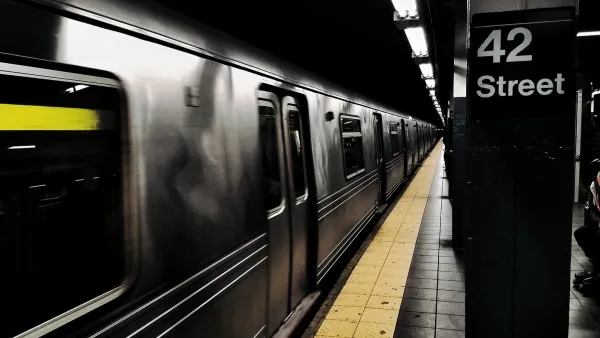Editorializing on the expected fare increase for New York City's 8.5 million transit riders, the Times suggests ways to soften the blow. Writing in response, the president of the Citizens Budget Commission suggests looking toward motorists.
The proposed fare increases would not just affect New York City's buses and subways but also the two commuter railroads, Metro North and the Long Island Rail Road, and also the tolls on the seven bridges and two tunnels managed by the Metropolitan Transportation Authority (MTA).
The editorial and letter to the editor present different farebox recovery figures for the country's largest and most-used transit system.
Per the Oct. 13 editorial, "New York subway riders, for example, contribute 72 percent of the cost of their commute, compared with 53 percent in Chicago and 34 percent in Atlanta". Carol Kellermann, President of the Citizen's Budget Commission, writes in her Oct. 21 "Letter to the Editor", "transit riders now pay less than half the cost of their rides. By its own analysis, the M.T.A. recovers only 36 percent of its costs through fares systemwide."
The editorial suggests that MTA look toward the state to soften the fare increase, particularly on low income New Yorkers who can least afford the fare increase.
Ms. Kellermann suggests to increase the revenue the MTA already gets from those who drive.
"Rather than look for more state tax revenues, a better approach would be to seek a greater cross-subsidy from motor vehicle users, who benefit from the reduced traffic that mass transit makes possible. The M.T.A. already uses some of its toll revenue to cover mass transit costs, and it receives a portion of the license and registration fees the state charges drivers.
These sources and new ones, such as tolls to enter the central business district, are preferable on efficiency and equity grounds to relying on more general taxes or on fare increases above half the actual costs of providing a ride."
As for the actual toll and transit increases, MTA has four proposals for raising NYC bus and subway fares, with the first one to increase the present $2.25 fare to $2.50. Public hearings begin on Nov. 7.
Thanks to New York Times Subway News Alerts
FULL STORY: EDITORIAL: Another Fare Increase?

Analysis: Cybertruck Fatality Rate Far Exceeds That of Ford Pinto
The Tesla Cybertruck was recalled seven times last year.

National Parks Layoffs Will Cause Communities to Lose Billions
Thousands of essential park workers were laid off this week, just before the busy spring break season.

Retro-silient?: America’s First “Eco-burb,” The Woodlands Turns 50
A master-planned community north of Houston offers lessons on green infrastructure and resilient design, but falls short of its founder’s lofty affordability and walkability goals.

Test News Post 1
This is a summary

Analysis: Cybertruck Fatality Rate Far Exceeds That of Ford Pinto
The Tesla Cybertruck was recalled seven times last year.

Test News Headline 46
Test for the image on the front page.
Urban Design for Planners 1: Software Tools
This six-course series explores essential urban design concepts using open source software and equips planners with the tools they need to participate fully in the urban design process.
Planning for Universal Design
Learn the tools for implementing Universal Design in planning regulations.
EMC Planning Group, Inc.
Planetizen
Planetizen
Mpact (formerly Rail~Volution)
Great Falls Development Authority, Inc.
HUDs Office of Policy Development and Research
NYU Wagner Graduate School of Public Service


























